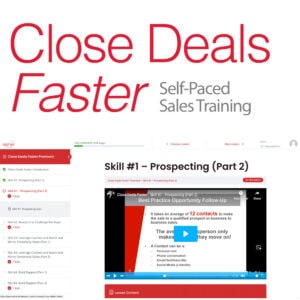Importance of Rapport Building Using Cognitive Biases

Most buyers do not consider salespeople to be “safe” as they know salespeople want their money.
“Action Selling” tells us that buyers make five decisions when buying products and services and they ALWAYS make them in the same order.
- First: They have to “buy” the salesperson.
- Second: They have to buy the salesperson’s company as credible.
- Third: They have to buy the products or services being offered.
- Fourth: They have to buy the price as reasonable for the value received from products or services.
- Fifth: They have to decide “when” to buy.
It is this last decision that causes most companies to have a “clogged” pipeline.
If the prospect does not “buy” the salesperson, the probability of closing a deal will be extremely low. Therefore, rapport building is extremely important so that candidate feels comfortable with the salesperson.
Three cognitive biases are particularly important in building rapport.
- The first is the “compliment” bias. We are positively biased towards people that compliment us. The elite salesperson will research the prospect and their company with two great AI tools in sales navigator; lead IQ and account IQ. They will develop a compliment that is authentic, specific, meaningful and sincere. Examples would be the company’s reputation, a video they watched on their website or an example of their community involvement. A compliment about the prospects blouse or shift would not suffice!
- Second, they will use the “reciprocity” bias by providing the prospect with a gift such as a relevant book. This gift generates a need in the buyer’s emotional unconscious brain to return the favor or gift. The return that the salesperson wants is the prospects business.
- Third, salespeople will use the “similarity” bias to appear “safe” to the prospect.
Our ancestors developed cognitive biases as a way to save energy. The energy was needed to hunt game so they could survive.
As an example of the similarity bias, when a homo sapien meet another homo sapien in the jungle or on the savana, they looked “safe”. When a homo sapien met a Neanderthal, they did not look safe. This bias probably explains why the Neanderthals never survived as a species.
The similarity bias is therefore an extremely strong bias. The elite salespeople use it in three ways to build rapport with the candidate.
First, they will thoroughly research the background of the candidate to find similarities in their backgrounds. They will use lead IQ in sales navigator and all social networking and social media platforms to do so. Then, when they first interact with the candidate they will use the similarity bias to get the initial conversation going. Once the conversation is going they will keep the conversation going as long as the prospect wants. If the salesperson shifts the discussion prematurely to business, it signals to the buyer that they have “commission breath”.
Secondly, once the conversation is going, the salesperson will use neuro-linguistic programming (NLP) to “appear” similar to the candidates unconscious emotional brain.
- If the candidate is speaking quickly, the salesperson will speed up.
- If the candidate is speaking softer, the salesperson will speak softer.
- If the prospect uses acronyms associated with their industry, the salesperson will include those acronyms in their conversation. If the prospect switches their body posture, the salesperson will slowly move to match their posture.
In a very short period of time, the candidates unconscious brain will signal to their rational brain that the salesperson is just like them and therefore AWESOME!
Third, salespeople will use the web app crystalknows.com to determine the personality style of the candidate (Driver, Thinker, Communicator or Supporter). They will use the information to expertly mirror the personality style of the candidate.
Once rapport building is over (let the candidate decide), shift into a discovery process to determine the challenges and aspirations of the candidate. Keep asking questions (the “5 Whys”) until you have a thorough understanding of the candidate’s needs.
Once you have this understanding, describe your offering using the BIG picture and concentrate on the relevant features that respond to the candidates needs.



